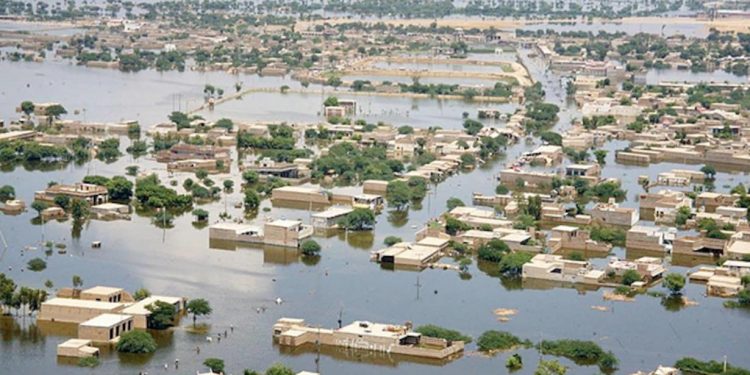Millions of people in Pakistan are in need of aid as flood ravages the country, leaving a 3rd of the Asia country flooded. Pakistan has been hit by monsoon rains that begin in June, thereby leaving majority of her largely poor population in need of aid.
BASIC FACTS
- Pakistan is facing a a major flood crisis, the biggest in the most recent history of the Asian country.
- The flood is following the monsoon rain which started in June, and the worst Pakistan is facing in a decade.
- Over 1000 lives have been lost to the flood and the count is still mounting.
WHAT WE KNOW
Aid efforts are been ramped up across flooded Pakistan on Tuesday to help tens of millions of people affected by relentless monsoon rains that have submerged a third of the country and claimed more than 1,100 lives.
The rains that began in June have unleashed the worst flooding in more than a decade, washing away swathes of vital crops and damaging or destroying more than a million homes.
Pakistani authorities and charities are working to accelerate aid delivery to more than 33 million people affected. Delivery aid has become a challenging task in areas cut off because roads and bridges have been washed away by the flood.
In the south and west, dry land is limited, with displaced people crammed onto elevated highways and railroad tracks to escape the flooded plains.
Pakistan is not new to heavy downpours, as the country experiences annual monsoon rain, which though is often destructive, it’s nonetheless useful for agriculture and water supplies. However, nothing like what is happening this year has been experienced in over 30 years (three decades).
Pakistani officials have blamed climate change, which is increasing the frequency and intensity of extreme weather around the world. Pakistani Planning Minister Ahsan Iqbal said Pakistan needed more than $10 billion to repair and rebuild damaged infrastructure.
The Indus River, which runs along the length of the South Asian nation, is threatening to burst its banks as torrents of water rush downstream from its tributaries in the north.
Pakistan as a whole had been deluged with twice the usual monsoon rainfall, the meteorological office said, but Balochistan and Sindh provinces had seen more than four times the average of the last three decades.
The disastrous flood is made worse, as it came at a time Pakistan economy is in on a free fall.
Pakistani government has appealed for international help, while declaring the situation an emergency.
Aid flights have arrived in recent days from Turkey and the UAE, while other nations including Canada, Australia and Japan have also pledged assistance.
The United Nations has announced it will launch a formal $160 million appeal on Tuesday to fund emergency aid. Pakistan, given the free fall she is experiencing in economy, was already desperate for international support, only for the floods compound the already dire challenging situation.
The flood in a third of the country, has further led to a soaring price of basic goods, particularly onions, tomatoes and chickpeas. The above has been blamed by traders on a lack of supplies from the flooded breadbasket provinces of Sindh and Punjab.
Pakistan felt some relief on Monday, as the International Monetary Fund (IMF), approved the revival of a loan programme for Pakistan, releasing an initial $1.1 billion.
Makeshift relief camps have sprung up all over Pakistan, schools, motorways and military bases have seen the rise of camps.
In the northwestern town of Nowshera, a technical college was turned into a shelter for up to 2,500 flood victims.
NOTABLE QUOTES
Rimsha Bibi, a school girl in Dera Ghazi Khan, Central Pakistan who spoke to AFP said, “We don’t even have space to cook food. We need help,”
Malang Jan, a 60 year old Pakistani said, “I never thought that one day we will have to live like this,”
“We have lost our heaven and are now forced to live a miserable life.”
Pakistani government Climate Change Minister, Sherry Rehman told AFP, “To see the devastation on the ground is really mind-boggling,”
“When we send in water pumps, they say ‘Where do we pump the water?’ It’s all one big ocean, there’s no dry land to pump the water out.”
“literally a third” of the country was underwater, comparing scenes from the disaster to a dystopian movie.”
The Planning Minister Ahsan Iqbal said, “Massive damage has been caused… especially in the areas of telecommunications, roads, agriculture and livelihoods,”
COMMENTARY
The increasing frequency of climate change related disaster, is a wake up call to authorities around the world, Nigeria in particular to put her house in order especially as warnings of flood is some parts of the country has been announced by NIMET.
Yes we may not experience anything near what is happening in Pakistan, nonetheless, government can start identifying and making plans for would be safe havens in the event of environment crisis.
Climate change from ozone warming has been blamed for the soaring warmth and disastrous rainfalls across the world. Notwithstanding, there are still countries and government very much in denial of the reality of climate change and the dangers it portends to humanity.












